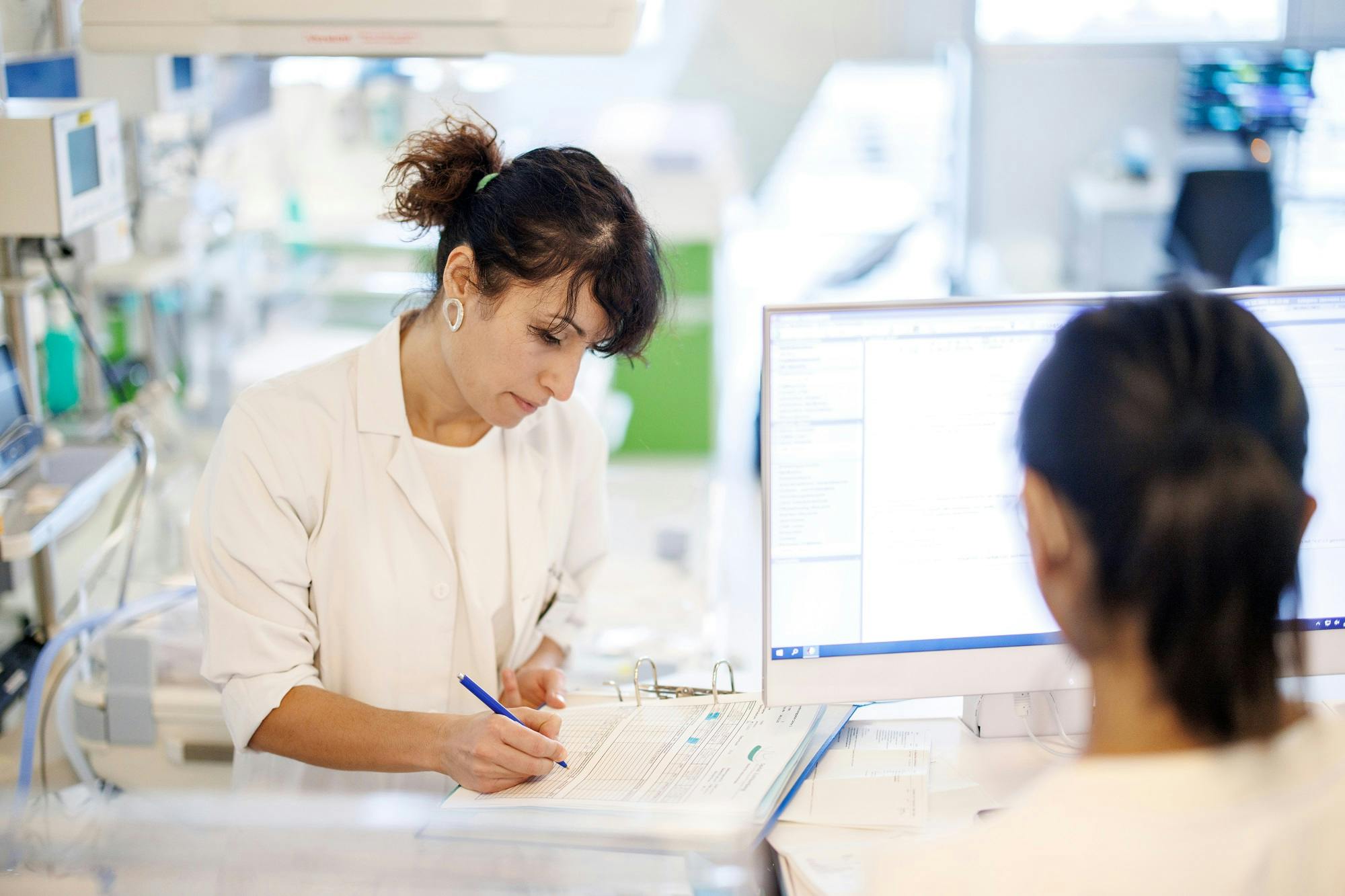Heart attack: vital first aid
Dr. med. univ. (S) Linn Ryberg
October 10, 2023
10 min
Dr med. univ. (S) Linn Ryberg, how long does it usually take from the first symptoms to a heart attack?
A heart attack rarely occurs like a flash and without warning. Warning signs are often present hours, days or even weeks and months in advance. Typical symptoms are pressure or pain in the chest, especially during physical or emotional stress. Angina pectoris (Latin for chest tightness or tightness in the chest) is caused by a temporary lack of oxygen in the heart muscle, especially in situations of increased stress. If the lack of oxygen in the heart persists, heart muscle cells die, resulting in a heart attack. While the episodes of pain in angina pectoris are shorter in duration, they usually last longer than 15 minutes in heart attacks.
0/0
Why does a heart attack lead to cardiac arrest?
In a heart attack, the blood flow to the heart is disrupted. Due to the resulting lack of oxygen in the cells in the heart, these are damaged and die. This can disrupt the electrical activity in the heart and increase the risk of arrhythmias developing. Some of these arrhythmias are life-threatening. In the case of very rapid arrhythmias, such as ventricular fibrillation, the heart can no longer contract and relax; it stands still. If blood is no longer pumped to the brain or into the body, this will inevitably lead to loss of consciousness or death if this condition cannot be rectified quickly.
What correct and important first aid measures should people take immediately if they suspect a heart attack?
The first thing you should do is call the emergency number 144 to minimise the time it takes for the emergency services to arrive. You should stay on the phone until the paramedics arrive. If the diagnosis of a heart attack is confirmed, every minute counts. The affected person should be positioned as comfortably as possible, if possible with the upper body slightly elevated to relieve the strain on the heart. It is important not to leave the affected person alone, also because of the existing risk of cardiac arrest.
In the event of cardiac arrest, you should call loudly for help so that the tasks can be divided among several helpers if possible. If you have not already done so, you should call 144 now at the latest and start chest compressions or cardiopulmonary resuscitation. If you are unsure how to perform chest compressions, the rescue coordination centre will instruct you accordingly over the phone. Chest compressions are performed in the centre of the chest on the lower half of the sternum. Compressions should be made five to six centimetres deep at a rate of approximately 100 per minute. For people who are experienced in first aid, it is recommended that in addition to chest compressions, ventilation is given at a ratio of 30 compressions to two ventilations. While someone is performing chest compressions, another person should fetch a defibrillator.
0/0
Someone finds a defibrillator in the neighbourhood - can laypersons operate it?
There are so-called automatic defibrillators (AED) that are specially designed to be operated by laypersons. After attaching the adhesive electrodes to the patient's chest (corresponding drawings on the electrodes or the device), the AED guides the first aider through the resuscitation using voice commands. We also have non-automatic defibrillators in the hospital, which should only be operated by medical staff. AEDs can be found, for example, in fire stations and police stations, schools, universities, shopping centres, businesses and other public facilities. AEDs can also be found in leisure facilities such as swimming pools, cinemas and museums. You can find out where defibrillators are available on the defikarte.ch website. Early defibrillation can save lives. If defibrillation is not required, the device will not trigger a shock. Using an AED can therefore only help and not cause any further damage.
And what is absolutely not to be done in such an emergency situation?
Never leave someone with a suspected heart attack alone. As already mentioned, there is always a risk of cardiac arrest in the event of a heart attack and therefore the need for rapid resuscitation. A cardiac massage can be life-saving in such a situation, even if it is performed by a layperson. In this case, evidence of unconsciousness and the supposed lack of sufficient breathing are sufficient to justify the start of chest compressions. Not performing chest compressions in the event of a cardiac arrest significantly reduces the victim's chance of survival, even if the emergency services arrive on the scene quickly. For every minute that passes, the probability of survival decreases by ten per cent. Only around five per cent of those affected survive a cardiac arrest outside the hospital. That's why every second counts.
If a cardiac arrest occurs while driving, it can be potentially fatal for the person affected, but also for third parties. For this reason, you should not drive yourself if you suspect a heart attack. In order to minimise the body's oxygen requirements, you should refrain from exertion and instead adopt as comfortable a position as possible.
Are there certain medications that can help the affected person immediately in the event of a heart attack?
The most important thing in a heart attack is to reopen the affected, incompletely or completely occluded vessel in the heart. This requires a cardiac catheter examination to be carried out as soon as possible with the possibility of widening the vessel using a balloon or stent. The urgency of this examination depends on the patient's symptoms, the cardiac waveform (ECG) and certain blood values and varies between as early as possible and within the next few days. Blood-thinning agents such as aspirin and heparin are used to help open up a vessel in the heart that has been blocked by a clot. These are administered in combination with a strong painkiller such as morphine via the vein by the emergency services.
0/0
Sometimes, as we all know, the heart stings. Am I right in thinking that this is completely normal and nothing to worry about?
An occasional short stitch above the chest should not really be a cause for alarm. However, if the discomfort lasts for minutes, occurs repeatedly and reproducibly during certain activities (physical or emotional stress), a cardiological assessment should be arranged. The threshold for a cardiological assessment should be set low, especially for people with risk factors such as high blood pressure, diabetes, smoking, obesity and possibly known high blood lipid levels.
0/0
Weitere Beiträge
Counsellor
Understanding panic attacks: What triggers them and how to counter them
Panic attacks are like sudden storms in the soul - they strike unexpectedly, unleashing a wave of intense fear and often leaving confusion and uncertainty in their wake. But what exactly is a panic attack, how are they diagnosed and treated, and what can sufferers do to deal with them? To delve deeper into this topic, we spoke to Dr Ruedi Schweizer, Medical Director of our Centre for Mental Health.
Counsellor
Can psycho-oncological support improve the chances of recovery or the quality of life of breast cancer patients?
In psycho-oncological topics, you and your relatives will be accompanied through all phases of the illness by experienced psychologists specialising in psychotherapy and specialists in psychiatry and psychotherapy. In this way, we can provide relief, give courage and open up new perspectives. Dr Ruedi Schweizer, our expert in psycho-oncology and Medical Director of the Centre for Mental Health, explains in the following video.
Counsellor
Focus on women's health: An interview with Dr Julia Graf, specialist in gynaecology and obstetrics
On International Women's Day, we would like to focus on women's health. To this end, we met with Dr Julia Graf, an experienced specialist in gynaecology and obstetrics and senior physician at the Women's Clinic, to talk about various aspects of women's health.


